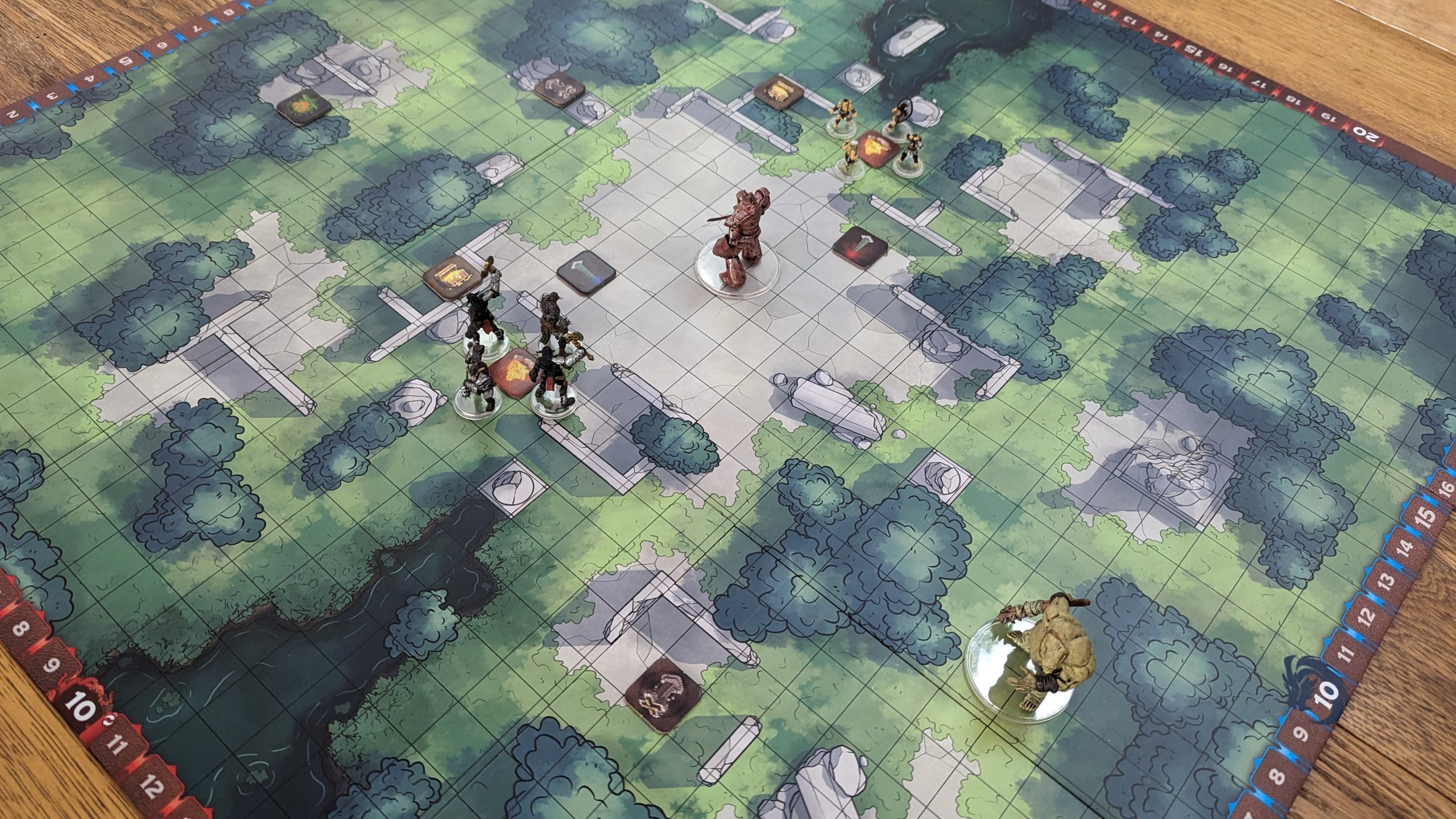
Credit where it’s due, Trials of Tempus is certainly an ambitious title. For his debut, lead designer Thor Knai tossed Dungeons & Dragons, MOBAs, and skirmish miniatures games into a blender, which resulted in some really cool ideas. The finished product is a 3v3 or 4v4 team board game of scrambling around a grid map to earn VP by killing monsters, looting chests, doing quests, and occasionally killing an opponent to steal their loot. If that sounds like a lot of fun, it definitely is in theory, but unfortunately Tempus has so many missteps in its box that we were left wanting a second edition or full-on reimplementation.
The production errors are the easiest to critique and dovetail nicely into talking about the game as a whole, so let’s start with them. The board(s) is immediately striking the second you take it out the box, as it comes in nine separate squares. At first glance, I had assumed that it was to make board setup variable like in Samurai or Power Grid, but upon closer inspection I noticed that various tracks and grid reference numbers are printed around the edges of the assembled board, meaning you’ve just got the two maps from the two sides. I understand it’s not that big of a deal, but I have games with bigger folding boards or boards that come in multiple pieces have jigsaw style connections to make setup easier and avoid the constant bumping and shifting that we endured. Speaking of setup, it’s an absolute nightmare. After choosing which of the two maps you want to play on and determining your quest set, you’ve got to seed your map with monsters and quest objectives, whose placements are depicted in the rulebook instead of having any form of marking on the board itself. Then, teams build their lineups by picking a class, subclass, and character for each player, which brings up another questionable production decision. While the rules insist that you’re free to smash up any combination of class and character, the player board has both your class and the suggested paired character on it, which has repeatedly led to confusion once we started deviating into our own combinations.

Things don’t get much better when you dive into actual gameplay, as a combination of vague wording and poor design decisions that draw out an overlong game turn playing Trials of Tempus into an absolute slog. Line of sight isn’t fully explained in the rulebook, and the graphic doesn’t actually clarify the multiple gaps left after reading. Each round starts with a draw phase where players draw 2 cards from your deck, replacing some level one cards with level twos and flipping basic tableau cards, strengthening your character. For whatever reason, there’s a new initiative roll every round, which is already a bad decision as it adds another phase that unnecessarily lengthens the game, but combined with ongoing cards that require spending an action to keep in play you wind up with an absurdly variance of efficacy, making the game feel more than a little broken. If I hit something with a ray of enfeeblement before their go on a round and then the initiative roll in the next round has me going after them, it hits them for two rounds although it’s obviously balanced around the action cost to keep up for multiple rounds. Similarly, if I hit them late in a round with the initial card and go before them in the next round, I’m left spending two actions to get a single trigger. These cards are obviously balanced around the upkeep cost, which doesn’t work with the constant flux of initiative from round to round.

The game itself has every player taking two actions a round on their turn in a team race to 10 VP through completing quests for variable VP and picking up loot worth 1 VP apiece. Once a team hits that magic number, the trial guardian will spawn in the middle of the map, but the game won’t end until it’s defeated. These monsters are wildly overtuned, taking a max player count team of 4 multiple rounds to chew through their insane health pools, all the while the other team is free to wail on the leaders, probably killing them and making them drop their loot since the monsters also have overtuned, insanely damaging attacks. Having players die at this stage absolutely blows, as it not only sets the team back all the VP from their dropped loot, but it also lengthens the game since the player gets removed from the board and spawns in their team’s corner next round, taking multiple rounds to get back to the middle of the board where they can have any effect on the game, making them twiddle their thumbs in a literal corner for a half hour in higher player count games. My shortest game lasted three hours, and that’s with the losing team throwing in the towel and helping kill the guardian so we could move on to other stuff.
Dungeons & Dragons: Trials of Tempus
Bad
Trials of Tempus was designed by D&D players who hadn't played a lot of modern board games without any tweaks made by those that have, which is made apparent by sloppy rules, production, and generally poor design choices. There's some promise here, but it would need a second edition it's probably not getting to ever hit my table again.
Pros
- Skirmish level wargaming with neat objectives and a boss fight climax
- Every mini is controlled by an actual player and there's only two teams, a new approach to making multiplayer minis games not devolve into an absolute clusterfuck
Cons
- Everything else
